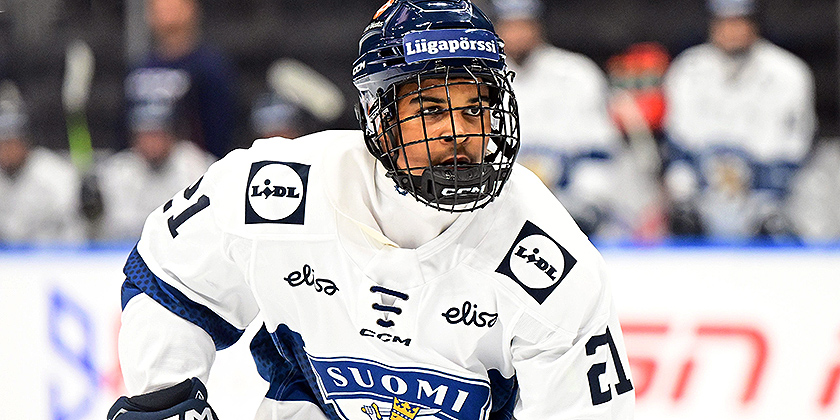
Max Westergard (LW, L, 5’10”, 161, Frolunda HC J20, 09/03/2007)
Max Westergard is a highly intelligent, agile, and competitive two-way forward with legitimate NHL upside if his physical tools continue to develop. Despite being one of the youngest players in the 2025 draft class, Westergard has already played SHL games with Frölunda and has produced at above a point-per-game pace at the J20 level (50 pts in 40 gms). He blends excellent skating mechanics, offensive instincts, and game processing with competitive habits and the ability to play in all three zones. While his size and physical maturity remain areas to monitor, his growth curve, pace, and hockey IQ suggest strong long-term value.
Why Max Westergard Should Be an NHL Draft Pick
- High-End Hockey Sense and Playmaking IQ
Westergard’s offensive zone awareness and anticipation are elite. His ability to find soft spots, draw defenders, and distribute pucks with purpose has made him one of the most productive draft-eligible forwards in the J20 Nationell — posting 50 points (19G, 31A) in 41 games. His 1.55 completed passes per game leading to a teammate’s Grade “A” scoring opportunity is a standout number and supports his reputation as a cerebral playmaker. - Outstanding Skating and Mobility
He plays with pace and agility, accelerating quickly out of his stride and attacking with intent. His ability to cut inside, drive wide with speed, and recover defensively is helped by a strong skating base and high motor. His transition game is a weapon, and he’s constantly moving his feet to create space or regain puck control. - Strong Production Against Older Competition
Despite being a September 2007 birthdate, he’s been one of Frölunda J20’s top scorers and has held his own during his SHL call-ups (6 games, 1 point). At the Hlinka-Gretzky, he led Finland in goals and was tied for second on the team in points, showing he can impact games internationally as well. His age-relative success is a major long-term projection indicator. - Elite Game Processing and Puck Anticipation
Statistically, Westergard is elite in terms of loose puck recoveries after shots (1.76/game) and takeaways (3.4/game) — clear indicators of his anticipation, awareness, and compete level. He reads plays a step ahead and shows strong commitment to supporting the puck in all three zones. - Plays Bigger Than His Frame
While just 5’10”, 160 lbs, Westergard doesn’t shy away from contact. He gives 0.19 hard hits per game, and more importantly, receives 0.69, meaning he’s willing to engage. He goes to the net, drives the middle, and battles along the walls. His 50% win rate in puck battles speaks to his tenacity despite his size.
Why Max Westergard Should Not Be an NHL Draft Pick
- Lacks Physical Strength and Still Growing Into Frame
At 160 lbs, he’s well below average for NHL or even pro European standards. He still loses too many puck battles against heavier opponents and gets pushed off pucks, particularly along the wall. His 0.37 penalties drawn per game suggests he’s not yet consistently winning physical confrontations or forcing defenders into bad spots. - Incomplete Offensive Finishing Profile
While he creates chances at a high clip (1.76 Grade A chances per game), his 14% conversion rate is average, and the volume of shots blocked (0.46 per game) and missed (0.7 per game) – he still needs to improve his shot release, deception, and expand his one-timer shooting zone. He can get to scoring areas, but his ability to finish consistently at higher levels remains in question. - Sloppy Puck Management at Times
Despite high-end IQ, Westergard is still refining his puck management, timing and offensive execution, especially under pressure. His 82% pass completion rate is below expectations for a top offensive forward, and his 5.3 giveaways per game point to a need to clean up risk-reward decisions and avoid forcing plays through seams that don’t exist. These issues show up more consistently when facing older, faster competition. - Needs Strong Development Support
Given his size, age, and areas for growth (finishing, physical maturity, play execution), Westergard will likely require a 3-4 year development path, ideally through the SHL and into North American pro hockey. He may not be an immediate asset in the AHL and could get lost in the shuffle without a clear plan from a development staff.
Projection and Final Verdict
Draft Range: Late 2nd to Early 4th Round
NHL Projection: Middle-six two-way winger with special teams value
Comparable: Jesper Boqvist (development path), Yanni Gourde (projection)
Max Westergard is a young, toolsy, high-compete winger with NHL skating, high-end hockey sense, and a well-rounded game. He’s trending toward being one of Finland’s top eligible forwards in a weaker draft class and has shown the ability to play up in age — both internationally and professionally. His ceiling will depend on how well he fills out physically and how quickly he can clean up puck management and develop his finishing ability. If a team is willing to be patient, they may be rewarded with a smart, pace-driving winger who can complement skill players in a middle-six NHL role.
Recommendation: Should be strongly considered in the late 2nd or early 3rd round by a team with a strong development pipeline and willingness to invest in his physical growth over a longer time frame.
